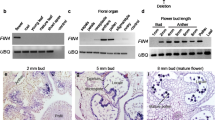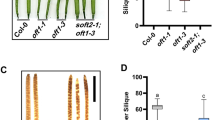Abstract.
Arabinogalactan-proteins (AGPs) are proteoglycans with a high level of galactose and arabinose. Their current functions in plant development remain speculative. In this study, (β-D-glucosyl)3 Yariv phenylglycoside [(β-D-Glc)3] was used to perturb AGPs at the plasmalemma-cell wall interface in order to understand their functional significance in cell wall assembly during pollen tube growth. Lily (Lilium longiflorum Thunb.) pollen tubes, in which AGPs are deposited at the tip, were used as a model. Yariv phenylglycoside destabilizes the normal intercalation of new cell wall subunits, while exocytosis of the secretory vesicles still occurs. The accumulated components at the tip are segregated between fibrillar areas of homogalacturonans and translucent domains containing callose and AGPs. We propose that the formation of AGP/(β-D-Glc)3 complexes is responsible for the lack of proper cell wall assembly. Pectin accumulation and callose synthesis at the tip may also change the molecular architecture of the cell wall and explain the lack of proper cell wall assembly. The data confirm the importance of AGPs in pollen tube growth and emphasize their role in the deposition of cell wall subunits within the previously synthesized cell wall.
Similar content being viewed by others
Author information
Authors and Affiliations
Additional information
Received: 14 August 1997 / Accepted: 9 September 1997
Rights and permissions
About this article
Cite this article
Roy, S., Jauh, G., Hepler, P. et al. Effects of Yariv phenylglycoside on cell wall assembly in the lily pollen tube. Planta 204, 450–458 (1998). https://doi.org/10.1007/s004250050279
Issue Date:
DOI: https://doi.org/10.1007/s004250050279




